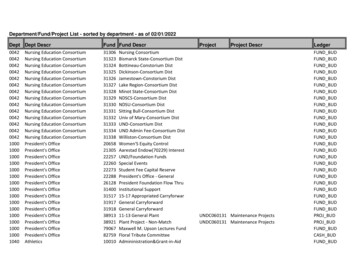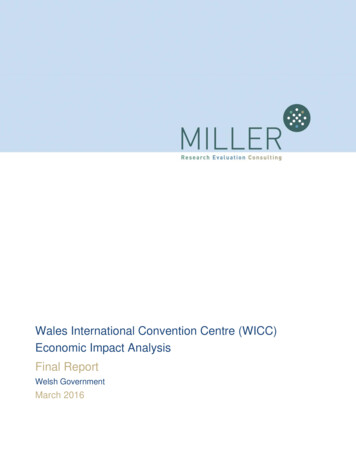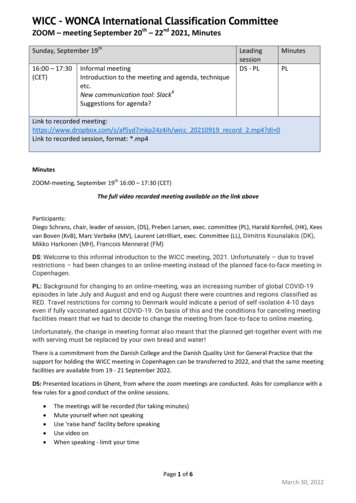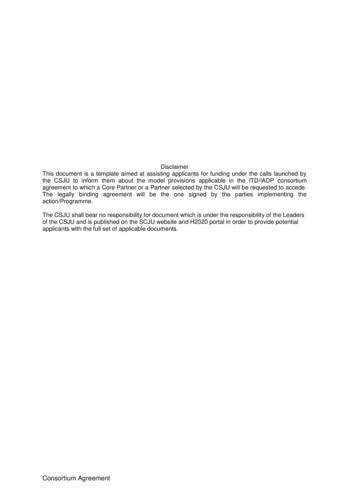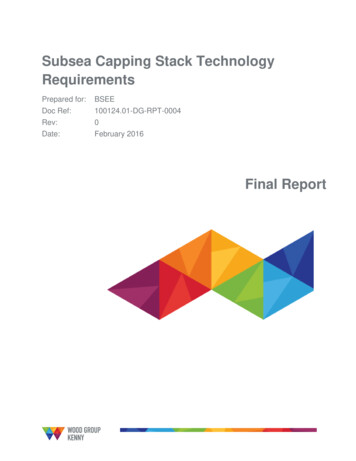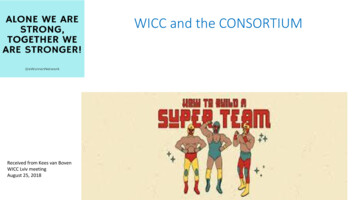
Transcription
WICC and the CONSORTIUMReceived from Kees van BovenWICC Lviv meetingAugust 25, 2018
Exchanging knowledge during the whole year
LINKING PIN
ABOUT THE CONSORTIUMFor the development of the new ICPC-3 a Consortium is in place inwhich the project is undertaken. At the moment the Consortiumconsists of WONCA World, WONCA Europe, Radboud UniversityNijmegen and a number of participating countries.The Consortium is open for new partners if they want to contribute,financially or otherwise. The benefits of taking part in the ICPC-3Consortium is twofold: having influence on the content of ICPC-3and a user license for the ICPC-3!
In the ICPC-3 Project a new version of the ICPC and an Interface Terminology for PrimaryCare is under development, based on a novel approach for classification development, i.e.based on a content-model. This novel approach takes into account all desired uses of ICPC in International anddifferent National Primary Care settings. There will be consistency with the principle of interoperability within the Framework ofInternational Classifications and Clinical Terminologies. It is also aimed to create a stable model to support continuous central development andmaintenance of the ICPC and Interface Terminology. The ICPC-3 Project Secretariat is hosted by the Department of Primary and CommunityCare / Radboud University Nijmegen, the Netherlands. The ICPC-3 Consortium is founded specifically for the development and maintenance ofICPC-3.
THE ICPC CONTENT MODELAny Rubric/Category in ICPC is represented by:Descriptive characteristicsMaintenance attributes1.A.Unique identifierB.Subset, adaptation, and special view flag1. Country adaptation2. Research3. Special indices (e.g. Public HealthIndices or Resource Groupings,Case-mix)C.Hierarchical relationshipsParents and children in the ICPC structure:ChapterComponentOrgan systemD.Mapping relationshipsLinkages to other systems like ICD-10 ICD11, ICF, ICHI, SNOMED etc.Linkages to ICPC-1, ICPC-2E.Other rules2.3.TITLE of Entity: Name of rubrica.Textual description, concise an detailedb.Short title - Inclusion – Exclusion - Index terms/synonyms– Coding hint - NoteType of Entitya. Symptoms and complaintsb. Interventions and Processesc. Diagnosis, Care and Clinical Findingsd. Functioning - functions, activity and participatione. Functioning related factors – personal factors,environmental factorsTemporal Propertiesa.Duration, course, age of occurrence, stage4.Severity and/or – existing severity scales- ICF scale5.Manifestation – Laboratory - Imaging and Clinical findings6.Causality - in disease component (congenital/hereditaryinfectious, neoplasm, trauma,
What will be new?Person-Centeredness at the core of ICPC-3!The leading principles are:Relevant National content within ICPC-3 to suit National Primary Care needs.The rational for additions to ICPC-3 will still be: frequency and evidence based.Familiar will be the simplicity of the new ICPC-3, no excessive subclasses like mostclassifications and clinical terminologies.The content of ICPC-3 will be ‘linked’ to relevant classifications, such as ICD-10, ICD-11, ICF,ICHI and clinical terminologies such as Snomed-CT.
Present progressTo achieve the new content, the first step is the review of present content of the ICPC 2.7,from an International and National perspective.International: this work takes place within the Consortium Core-Group and the WICCTaskforce-A. The input from Taskforce-A is through membership of the ICPC-3 ConsortiumTaskforce. As a dedicated body represented within the Consortium by one of the Taskforcemembers, the WICC members are reviewing all chapters of ICPC 2.7, based on a set ofcriteria. The result of the review is provided as proposals to and processed by the ICPC-3Consortium Secretariat, in view of the criteria.
National: the Country Members of the Taskforce are reviewing theICPC 2.7 on content that is of relevance, and is not present, orcannot be registered as a separate entity for the Countries ownneeds.All results of the reviews are processed within the ICPC-3 Commentsite.A view on the Comment Site: next slide
About ICPC-3In daily practice of Primary Care, Community Care and Public Health manystandards are used. In Primary Care the ICPC or ICD is the starting point forregistration and documentation: the “data”.Most of the data is for use within the Primary Care setting itself, some data isused for referral, also some data comes back after consultation of a medicalspecialist or dismissal from a hospital.Data that is received by others or is sent by others in most cases will requiremore detail or contain more detail. For Primary Care as such, a high level ofdetail is not required, even not wished for. Adequate is what is needed. Noexcessive detail, tailored to Primary Care and bridged to classifications withmore detail.
The ICPC-3 content therefor will contain linkages to severalstandardized classifications and clinical terminologies. This is what isgenerally called a ‘telescopic’ view.Starting with the categories or class in ICPC-3, when more detail isneeded zooming-in to either ICD for diagnostic terms, ICF forfunctioning or ICHI for interventions.The other way around; when detailed data is received, zooming-out tothe relevant ICPC-3 categories/classes.
Including these linkages in ICPC supports the principle of continuity of datawithin and between health-care providers, but also supporting the use ofICPC, or ICD within a country, without losing the possibility to collect orexchange information for different purposes, such as direct patient care,research, reimbursement, aggregation or dis-aggregation, etc.
For the information exchange process, standardization is requiredon a different level: secure the meaning of the content by using thesame (clinical) terminologies, e.g. the use of the FoundationalModel of Anatomy (FMA) throughout all related classifications andClinical Terminologies such as Snomed-CT.
In addition to the ICPC-3, an Interface Terminology (Thesaurus) will be developed.This Thesaurus is a reference terminology for Primary Care that lists words groupedtogether according to similarity of meaning (including synonyms, or variants of terms). Themain purpose of such a reference work is to help the user “to find the correct word, orwords, by which [an] idea may be most fitly and aptly expressed”. In other words it is acontrolled vocabulary.The Thesaurus can be used as an interface-terminology, as it is already used partly in theNetherlands and Belgium in the EHR for GP’s/Primary Care.The Thesaurus we intend to develop will offer all the options or views that are needed,either to start searching from ICPC, ICD-10 or ICD-11. As Snomed-CT ID’s and possibly termswill be included, future implementations of SNOMED-CT can also be supported.
THE ICPC CONTENT MODELAny Rubric/Category in ICPC is represented by:Descriptive characteristicsMaintenance attributes1.A.Unique identifierB.Subset, adaptation, and special view flag1. Country adaptation2. Research3. Special indices (e.g. Public HealthIndices or Resource Groupings,Case-mix)C.Hierarchical relationshipsParents and children in the ICPC structure:ChapterComponentOrgan systemD.Mapping relationshipsLinkages to other systems like ICD-10 ICD11, ICF, ICHI, SNOMED etc.Linkages to ICPC-1, ICPC-2E.Other rules2.3.TITLE of Entity: Name of rubrica.Textual description, concise an detailedb.Short title - Inclusion – Exclusion - Index terms/synonyms– Coding hint - NoteType of Entitya. Symptoms and complaintsb. Interventions and Processesc. Diagnosis, Care and Clinical Findingsd. Functioning - functions, activity and participatione. Functioning related factors – personal factors,environmental factorsTemporal Propertiesa.Duration, course, age of occurrence, stage4.Severity and/or – existing severity scales- ICF scale5.Manifestation – Laboratory - Imaging and Clinical findings6.Causality - in disease component (congenital/hereditaryinfectious, neoplasm, trauma,
International: this work takes place within the Consortium Core-Group and the WICC Taskforce-A. The input from Taskforce-A is through membership of the ICPC-3 Consortium Taskforce. As a dedicated body represented within the Consortium by one of the Taskforce-members, the WICC members are reviewing all chapters of ICPC 2.7, based on a set of .


